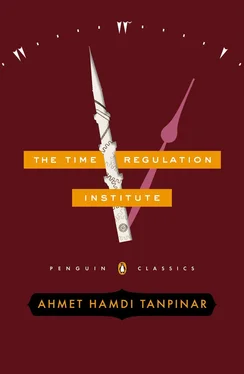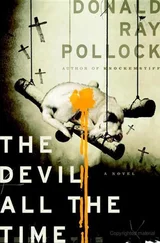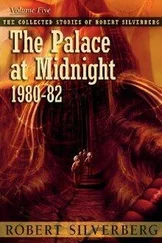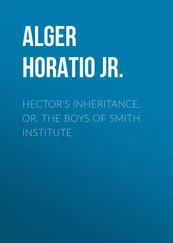Ahmet Zamanı’s April birthday had become the official International Time Day, as a matter of course. Our congresses were held every year on that date.
“All right,” I said. “But how can we achieve such a thing? However will we integrate a clock into the body — I mean, the building’s structure?”
He took his head in his hands.
“I don’t know,” he said. “Even I haven’t the slightest idea. We’ll leave it to the architects. They have to come up with a solution. Actually, the job falls to you. As it was you who added the condition, it should be you who comes up with the solution!”
He rose to his feet. He fixed his eyes on mine, and in his most serious tone of voice he slowly gave me his final word on the matter:
“You will have this building built, Hayri Bey. Is that understood? I will have no one else. You owe me this one — it’s personal!”
And so that’s how it happened. But only I know just how difficult it all was. The reason being that from the very beginning I was stuck on the idea of a pocket watch. Isn’t it often the case that most of the difficulties we face in our lives come from our stubborn embrace of the first idea that comes into our minds?
Though I had spent my entire life in the company of timepieces, I have always been most fascinated by the pocket watch, and this must be why I had been searching for the secret of the building in such a form. First I imagined a round building very much like a pocket watch, with twelve pavilions, representing the twelve different hours of the day, circling this hall. But once I’d tried to work out the idea on paper, I came to see it was impossible. Then I began thinking about how the watch might stand vertically. Stairs would provide access to a solid structure resembling a fat, swollen pocket watch mounted on four block pillars. Naturally the watch would have to have faces on both the front and the back, and windows would run down the sides of the building. So on each face of the building would be giant hands indicating the time, and in the middle of the facade would be a large door, accessed by stairs running up through one of the structural pillars.
But I had to give up on this idea as well, for Pakize was much too fond of it. I must admit that Pakize’s taste had become a sort of gauge for me. I had begun to question everything for which she expressed interest or enthusiasm. And, truth be told, the final idea did in a way come from Pakize. When I told her about my first idea, she responded with her usual carefree smile:
“I already know about it. Last night I had a lamb sacrificed for the Blessed One. Its spiritual powers have come to our aid.”
Initially I was taken off guard.
“Which Blessed One?” I asked. “What are you talking about?”
She calmly replied:
“Ah, my dear husband, you know — the Blessed One! Our prophet of a clock. You know it’s in your aunt’s house now! The one who comes to us in our hour of need!”
At first I thought I’d strangle her in a fit of rage, but then I suddenly embraced her. She had reminded me that the building didn’t have to be constructed in the shape of a round timepiece, that the world had timepieces of all shapes and sizes — that the building could easily take on a rectangular shape, like any other building worthy of its name.
“My dear wife,” I said. “I owe every success in my life to you. And now, thanks to your intercession, the Blessed One has come to our rescue. How can I express my gratitude?”
In fact it wasn’t at all difficult to design a long rectangular space in the shape of a grandfather clock. There was nothing we had to do, save place structures representing the hours of the day along the sides of the courtyard. The central hall would no longer be harnessed to the startling and indeed impossible height of my initial idea of the pocket watch. At the top of the courtyard would be a round, clock-shaped construction representing twelve o’clock. Then four small pavilions on each side would lead down along the courtyard to the pavilion representing six o’clock, which would have three floors. It would really be quite easy to suspend walkways above the strips of lawn between the pavilions. The large central hall would be enclosed in glass. And on the face of each pavilion a Roman numeral would be displayed, from one to twelve, moving, from right to left, in a large ring, just as it would be on a clock. In the end I decided that instead of using the number twelve, I would make the front-gate pavilion, occupying that numeral’s position, slightly larger than the others. To be sure to give the impression of a clock, I designed the front gate to resemble a dial. That said, my efforts to give a six-meter gate the appearance of a dial were truly exasperating. I would achieve nothing by putting yet more numerals along the sides of a normal rectangular shape. I needed a new idea. To this end I traveled as far afield as Bursa and Konya. And I visited all the mosques in Istanbul, looking closely at the many shapes of their doors, but they offered me nothing in return. Though all were beautifully crafted rectangles, they couldn’t help me with my problem. Then one night the idea came to me when I spied a curtain hanging in the door to one of the smaller mosques in Istanbul: I would use curtains to represent the hour and minute hands! After this it was simply a question of deciding what time I wanted these curtains to indicate over the top of the entrance. It was easy to manage such details once I could envisage a door with two curtains pulled halfway open, like wings.
It was summer. As usual Ahmet wanted to spend his vacation at a summer school. But at my insistence he agreed to stay at home to help me. He knew that I was under pressure, but it was also the sort of project that appealed to him. After seeing me struggling for hours on end, he didn’t have the heart to leave me stranded, even though he didn’t quite understand what I was up to — or perhaps simply found it too absurd for words. For the first time since Emine’s death, I felt truly happy. My son had not just forgiven me — he had undertaken to help me. I was overjoyed to have him working by my side, giving deep consideration to each and every possibility, and wrestling with matters that had no bearing on his life, just for the challenge. It was a true representation of the virtue we know as hard work.
Work makes us pure and beautiful; it is our bond with the outside world and makes us who we are. But work can also take possession of our souls. No matter how meaningless and absurd the job, we unwittingly become its prisoner: from the moment we accept responsibility for its proper execution we can never escape its grip. Herein lies the greatest secret of man’s fate and indeed the history of mankind.
In our first father-son discussion, we decided that the minute and hour hands shouldn’t be positioned at the same height, which would create an overly simplistic and classic symmetry.
So father and son sat together for hours on end, fiddling with watches, searching for the position that would best suit the curtains that would serve to represent the hour and minute hands by the angle at which they hung to either side. We wanted an angle that would seem natural at first glance but also out of the ordinary. A person rushing in would be sufficiently struck by the originality of the design to want to turn around and examine — if only for a moment or two — the large bronze numbers set into the white marble border around the door. If nothing else, he should think, “Oh yes, I really must have a look at that on my way out.” We finally decided on forty-two minutes past four. In so doing we cleared the space for a six-meter gate. And then, a meter and a half above the lintel, we fixed two stone curtains at different heights, depending on the time we had selected. The empty space on the left would be slightly higher, but both sides, even the point closest to the stone curtain’s edge, was just high enough for an average person to clear. To give a clearer indication of the hour and minute hands, we would place two thick, straight rods of engraved copper, or perhaps a copper-steel amalgam, in the folds of the stone curtains. A large pendulum would hang above the point where the curtains parted. This too would be forged of metal and sturdily affixed; as it swayed back and forth, it would represent the idea of regulation. And the awning over the door would create enough shade to bring out the richness of the green lintel, the white marble, and the burnished copper. Or so Ahmet thought.
Читать дальше












